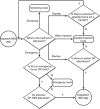Routes to diagnosis for cancer - determining the patient journey using multiple routine data sets
- PMID: 22996611
- PMCID: PMC3494426
- DOI: 10.1038/bjc.2012.408
Routes to diagnosis for cancer - determining the patient journey using multiple routine data sets
Abstract
Background: Cancer survival in England is lower than the European average, which has been at least partly attributed to later stage at diagnosis in English patients. There are substantial regional and demographic variations in cancer survival across England. The majority of patients are diagnosed following symptomatic or incidental presentation. This study defines a methodology by which the route the patient follows to the point of diagnosis can be categorised to examine demographic, organisational, service and personal reasons for delayed diagnosis.
Methods: Administrative Hospital Episode Statistics data are linked with Cancer Waiting Times data, data from the cancer screening programmes and cancer registration data. Using these data sets, every case of cancer registered in England, which was diagnosed in 2006-2008, is categorised into one of eight 'Routes to Diagnosis'.
Results: Different cancer types show substantial differences between the proportion of cases that present by each route, in reasonable agreement with previous clinical studies. Patients presenting via Emergency routes have substantially lower 1-year relative survival.
Conclusion: Linked cancer registration and administrative data can be used to robustly categorise the route to a cancer diagnosis for all patients. These categories can be used to enhance understanding of and explore possible reasons for delayed diagnosis.
Figures
Comment in
-
Emergency admissions of cancer as a marker of diagnostic delay.Br J Cancer. 2012 Oct 9;107(8):1205-6. doi: 10.1038/bjc.2012.423. Br J Cancer. 2012. PMID: 23047590 Free PMC article. No abstract available.
References
-
- Association of Breast Surgery (2011) Audit of Screen Detected Cancer, http://www.cancerscreening.nhs.uk/breastscreen/publications/archived-bas... (accessed 2 August 2012)
-
- Barrett J, Hamilton W (2005) Pathways to the diagnosis of prostate cancer in a British city. A population-based study. Scand J Urol Nephrol 39: 267–270 - PubMed
MeSH terms
LinkOut - more resources
Full Text Sources




